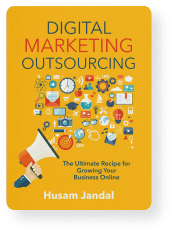 Does your business have a formal lead assignment method? If you’re investing in any kind of marketing strategy, it should.
Does your business have a formal lead assignment method? If you’re investing in any kind of marketing strategy, it should.
Each lead your business generates costs an average of $132 if you run a business services company per the Integrated Marketing Association. Those in tourism spend around $106, while financial services and healthcare companies spend around $160 per lead. While there are ways to optimize your spend and get more return on investment, and I use them as a business and digital marketing consultant, leads are an investment, and you don’t want to leave any on the table.
The challenge is, 23 percent of companies don’t respond to their leads at all, according to HBR research, and nearly a quarter takes more than 24 hours. Meanwhile, the likelihood of qualifying a lead is four times lower if a company waits 10 minutes to reach out versus contacting the lead within 5 minutes, according to the now-famous Lead Response Management Survey. At 30 minutes, qualification rates are 21 times lower.
Lead response time, or in this case, speed-to-lead, is of the essence. Also referred to as lead routing, lead assignment is the process of deciding which of your sales reps receives an incoming lead to work with, and it’s a crucial component of this. It can mean the difference between cultivating a lead that converts and one that goes stale or moves forward with a competitor before your team reaches out.
Where Does Lead Routing Fit into Lead Management?

Before I dig into lead assignment, let’s quickly go over the steps involved in lead management, so you can see when you’ll be applying the assignment model of your choosing.
Step 1: Lead Capture
Lead capturing is the first stage in any lead management strategy. This is where your marketing campaigns and lead generation tools go to work for you and deliver contact information of potential customers to your sales team. The lead source might be a digital channel such as blog posts, landing pages, or social media. It might also be an offline source, such as a word-of-mouth referral from an existing client. While some early-stage companies may use spreadsheets to track leads, A CRM is vital for creating effective workflows throughout the sales funnel and gathering metrics as the number of leads your team is working with grows.
Step 2: Lead Enrichment
You may not know much about a prospect based on the interaction that caused them to become a lead, so it’s helpful to do some research. This can be done in a low-tech way, such as by reading your B2B prospect’s website and marketing materials. It may also be done in more high-tech ways, including automated lead scoring. Under this model, each behavior a lead might engage in automatically adds or removes points from the lead’s score, so it’s easier to identify quality leads going forward. If it’s a manual process, this is where your sales development team usually steps in.
Step 3: Lead Qualification
Despite having completed a form or expressing interest in your products or services, an individual may not yet be a sales-ready lead, meaning they may not be someone your company can help yet. Furthermore, if you send these leads through to your sales team, they’re unlikely to convert, meaning they’ll take up the time of your sales team without giving any payout. With that in mind, your team should also put leads through a qualification process to ensure reps are working with leads that are likely to convert.
Step 4: Lead Distribution
When leads are qualified, they’re ready for distribution. You’ll learn about the various lead assignment rules in just a moment.
Step 5: Lead Nurturing (When Applicable)
Sometimes leads aren’t ready to convert but might otherwise be qualified. For example, a sales development specialist may discover that a lead needs to address some internal concerns before they can move forward, or a sales rep may find the lead is putting off bringing decision-makers into the discussion. Leads like this may someday convert, but they’re not ready yet. They can be placed in a nurturing workflow to help build the relationship until they’re ready.
What Kind of Lead Distribution Methods Are Available?

Historically, lead assignment was a manual process in which sales leaders handed off individual leads to specific reps as they came in. Now that we have marketing automation and lead management software, the process can be streamlined by a platform like Salesforce or HubSpot.
Most modern lead distribution models fall into one of two categories: push or pull. But, even within these broad categories, there are multiple methods too. I’ll break them down in detail below and also explore what hybrid models look like too.
How Do You Choose the Best Lead Distribution Method for Your Sales Team?
Push-Based Lead Distribution
As the name implies, a push-based lead distribution system sends new leads to sales reps automatically. The criteria used is what sets various types of push-based systems apart.
Top Producer
Do you have sales reps who close significantly more leads than others or generate more revenue for your company? Then, the top producer model may be a good choice. In short, you’ll place your “top producers” in one or more categories separate from your average producers or struggling sales reps. As leads are distributed, sales reps in the top producing categories will receive more leads or better leads than their counterparts.
Pros of Top Producer
By sending well-qualified leads to your top producers, you’re making the best possible use of their time and optimizing those leads for conversion. In addition, because most sales reps receive commission, you’re also rewarding your best performers with more lucrative opportunities.
Cons of Top Producer
Sometimes top reps become fatigued by the deluge of leads they receive under the top performer model. If any given sales rep has too many leads, they may not be able to give each the attention it deserves as well. By its very nature, this also means others on the sales team aren’t receiving the same quality or volume of leads, which can cause the disparity and resentment to grow.
Region-Specific
Companies with a local presence or products that differ by locale will often use a region-specific lead distribution model. For example, if the United States is your target market, you may have one rep covering Pacific states, another covering the Southwest, and another working on Mountain states. Multinational companies will often break theirs up by country or continent. The division is up to you based on what makes the most sense for your company.
Pros of Region-Specific
Region-specific may make the most sense if your products are subject to localized laws or guidelines, as reps will become more familiar with requirements for the regions they serve. The method also allows for coverage of different languages and time zones, plus makes it easier for reps to develop relationships with leads.
Cons of Region-Specific
The distribution of leads is rarely equal, and it’s not always possible to redistribute territories so that some reps will have more opportunities than others. Moreover, suppose one region experiences a temporary spike and reps aren’t able to keep up. In that case, reps covering other territories may not have the knowledge or skills required to help with the overflow.
Round-Robin Lead Assignment
Under the round-robin distribution model, leads are automatically forwarded to reps in the order they’re received. So, each rep will receive a lead until all reps have one. Then, the cycle will start over until each rep has a second lead. Thus, leads are distributed using the same process and cycle indefinitely.
Pros of Round-Robin
In theory, round-robin gives all reps equal opportunity and distributes the workload evenly. That means all leads are addressed as quickly as possible, and reps have the same earning potential.
Cons of Round-Robin
Round-robin doesn’t necessarily optimize for conversions since it doesn’t take expertise, skill, or buyer persona experience into account. In addition, leads can potentially go stale if a rep is slow or becomes tied up working on another deal.
Pull-Based Lead Distribution
Unlike the push-based options, which automatically match leads with reps, the pull-based methods require reps to claim leads. The rules your team sets for lead selection set the different types of pull-based lead distribution apart.
Cherry-Pick
With the cherry-pick method, reps choose which leads they want to work on from a general lead pool. However, they’re only permitted to select a lead from the queue when they have immediate availability to work the lead.
Pros of Cherry-Pick
Your reps are incentivized to work quickly with the cherry-pick method because it means they get the first choice from the lead pool and can potentially get more opportunities to close leads. Additionally, your most qualified leads are assured the quickest response, so conversion rates are boosted too. You may also find that reps intuitively choose leads that are well-suited to them based on skills, expertise, or personas, which increases the likelihood of closing those deals.
Cons of Cherry-Pick
Less desirable leads, such as those with lower scores or who meet fewer qualification requirements and those who are likely to have a lower payout for a rep, are often ignored in favor of better leads. Unfortunately, that means some can sit for several cycles, and others may never get the attention of your sales team.
Shark Tank
Shark tank works similarly to cherry-pick, but all reps are notified when a new lead comes in, and anyone can claim it immediately.
Pros of Shark Tank
Shark tank shares many of the same benefits of cherry-pick. Reps tend to select leads that are well-suited to them, which increases closes. Your most qualified leads will also get prompt attention.
Cons of Shark Tank
Because anyone can claim a lead under the shark tank method, some especially hungry reps may focus more on new lead notifications rather than working on the leads they already have. Lead hoarding, in which a rep takes more leads than they can reasonably manage, can also become a problem. Plus, the fastest fingers will grab the best leads, leading to inequality and hard feelings between team members.
Blind Pull
Blind pull also works similarly to cherry-pick in that reps can grab leads from the pool at will. However, all information related to the lead is hidden from the rep until the lead is claimed.
Pros of Blind Pull
Leads are far less likely to fall to the bottom of the barrel and be ignored with the blind pull method, so they’re more likely to be addressed in a timely manner. There’s also less risk of lead hoarding.
Cons of Blind Pull
Your sales team can’t choose leads that are suited to them, so they may have to put in more time doing homework or getting to know prospects. This can lengthen your sales cycle. It may also cause close rates to decline until reps gain more generalized knowledge.
Shotgun
If your company addresses different audiences or has very unique products, the shotgun method may be appropriate. Under this model, leads are divided into groups and made available to different teams. For example, maybe you operate a business process outsourcing company that offers customer contact centers, data entry, and accounting services. If a lead-related to data entry comes in, it’s made available only to your data entry sales team.
Pros of Shotgun
Because expertise is matched under the shotgun method, close rates will likely climb, and your sales cycle will likely become shorter. Additionally, efficiency remains high because there’s still competition between reps within the same team too.
Cons of Shotgun
Because there may be some carryover between groups and competition within groups, too, there’s some risk of lead hoarding and uneven distribution.
Hybrid Distribution
A hybrid distribution model involves using both push and pull methods depending on the circumstances. For example, let’s say you have a sales team with just five people on it. All five reps have similar knowledge and may manage both inbound and outbound leads depending on what comes down the sales pipeline on any given day. Your CRM system is loaded with outbound leads the team can contact, so they use the cherry-pick method throughout the day, claiming leads one at a time when they’re free. However, as prospects complete your lead generation forms, those inbound leads are also loaded into your CRM and assigned to reps using the round-robin method.
It’s easy to see how a hybrid method like this might work for a smaller company. When utilized properly, all leads will be addressed promptly, and work will be distributed evenly.
However, the same method might not work for a larger company. Reps may also become confused about which leads to work with or when to pull versus push. Furthermore, each method used is subject to any individual cons listed for that lead distribution type.
Get Help Perfecting Your Lead Management Process
There’s no singular best lead distribution method to incorporate into your lead management system. Instead, you’ll need to select the models that make the most sense for your company and refine your processes to ensure they produce results in the most efficient way possible. As a business and digital marketing consultant, this is one of the steps I take on every project just before we turn up the heat and start creating serious leads! If your small or midsize business is stalled or you’re not sure how to take it to the next level, contact me for a complimentary consultation.





































































